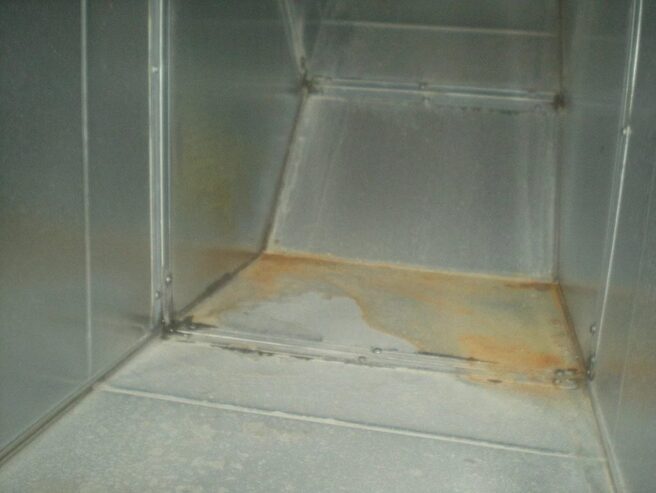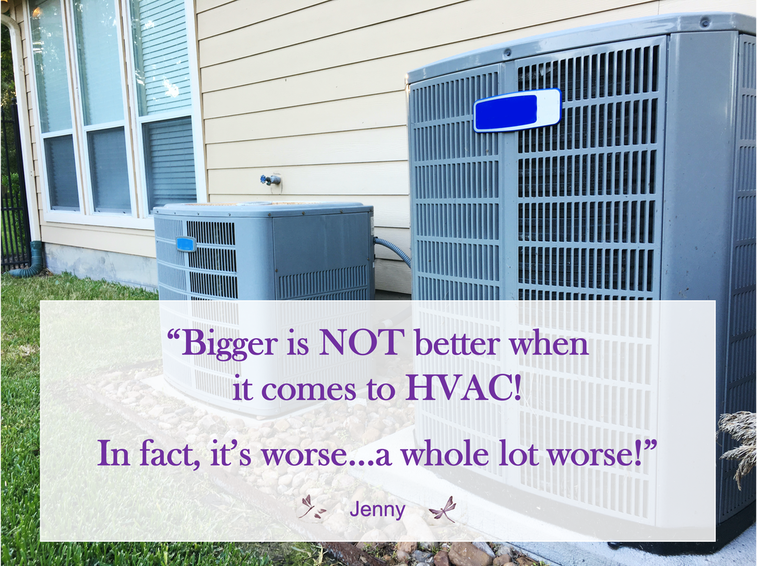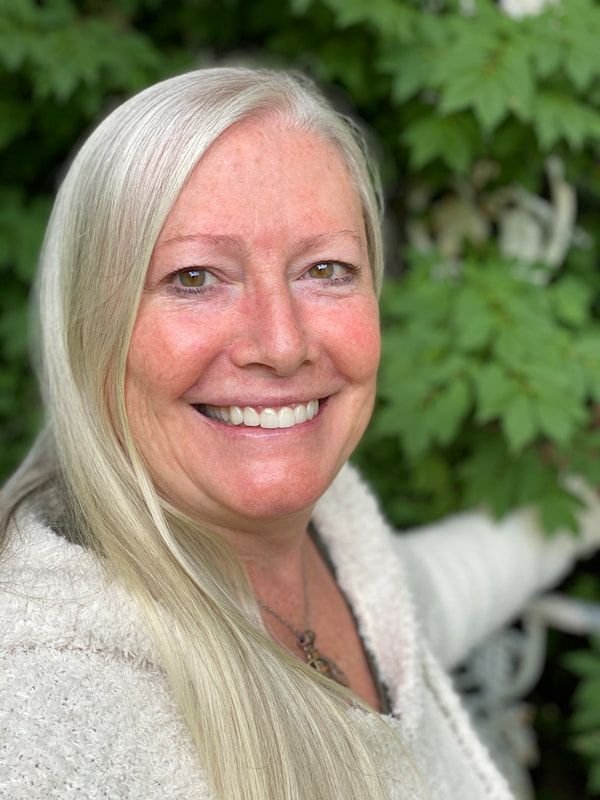
 Do NOT be fooled by the cheaper HVAC contractor bid! Most homeowners opt to go with the more affordable HVAC contractor when building their new home. And this makes sense. Why wouldn’t you? We’ve all been taught to shop around and find the best deal. In this fourth post of the Sick Home Series, I tell you why you should NOT pinch pennies when it comes to the heart of your home. I share industry secrets most homeowners do not know that could save you tons of money and help prevent serious health issues down the road. Secret #1: 90% of HVAC Systems are Designed and Installed Incorrectly! Yup, that’s right. The vast majority of HVAC systems are improperly sized and inadequately installed for the homes they’re designed for. How is this possible? A whole house systems approach is still far from the industry standard which leads professionals to become too specialized. For example, HVAC contractors typically don’t entirely understand how their systems must work cohesively with all the building materials of the home. The standard HVAC contractor is not adequately trained to design or install an HVAC system able to support today’s high-performance construction. This causes problems from the very beginning with an insufficient analysis of your home’s air flow and energy consumption demands. Most HVAC designers typically use the square footage of the home to calculate the size of required HVAC units. This is already a gross miscalculation. Since HVAC systems condition the air in the empty space of your home, square footage only provides 2 dimensions of a 3-dimensional problem. The ceiling height of every room must be considered to determine the CUBIC feet of conditioned space. This very basic understanding of what must be calculated is overlooked by most contractors, and unfortunately the industry is severely lacking in appropriate training and education. In addition, most HVAC designers fail to take into consideration how your home is insulated, how tightly sealed it is, how much and what type of glass it has, the direction your home faces, how many people live in it, and the many ways it interfaces with the environment…all of which have a significant impact on your home’s energy consumption. An inadequate analysis of your home almost always results in the installation of a unit or a series of units that are grossly oversized for your home’s conditioned space. Yes, that’s right, we said oversized. This is your typical overcompensation conundrum. When inadequate variables are considered, HVAC contractors will overcompensate with a large system that’s able to achieve desired indoor temperatures as opposed to running the risk of installing a too-small unit that’s not able to perform. Well, what’s the problem with an oversized unit? Most problems people have with their HVAC system are a result of an oversized unit! Bigger is NOT better when it comes to HVAC! In fact, it's worse...a whole lot worse! An oversized unit leads to higher monthly utility bills regardless of your home’s high-performance attempts. The higher monthly bills alone offset the savings you think you’re getting by going with the more affordable HVAC contract bid. A unit that’s too big for the conditioned space of your home can easily freeze the cooling coils which renders the entire system ineffective. The consistent stopping and starting of a too big unit results in motor burnout and fried electronics which significantly shortens the lifetime of your unit. More importantly, oversized units are FAR more likely to cause health issues resulting in possible doctor’s bills and remediation costs down the road. How an Oversized HVAC Unit Contributes to Health Issues Your HVAC system is responsible for heating, ventilating, and air conditioning the air inside your home. The HVAC system is ultimately responsible for your level of comfort inside. You probably already knew that. What you might not know is that every time you turn your air conditioner on, the HVAC system is also pulling moisture out of your indoor air…and your home is consistently requiring dehumidification. Moisture enters your indoor air with every shower you take, every meal you cook, and every breath you exhale. People produce 3 pints of water per day just by breathing and a 10-minute shower releases about 1 pint of moisture into the air. So, a family of 4 can release 16 pints of water into the air in a day just simply by breathing and showering. More astounding is the amount of moisture that enters your home through the ceilings, walls, floors, crawl spaces and/or your basement. Up to 100 pints per day can seep into the air of your home through a basement that’s not properly sealed. The relative humidity outside also effects your indoor air every time you open doors, windows, or air enters through fresh air intakes. Homes in particularly humid areas of the nation require particularly well-designed and installed HVAC systems. Here’s looking at you North Carolina! When an HVAC unit is too large for the volume of air it’s conditioning, it will flood too much cool air into the space, which means it will reach the temperature it’s set to achieve on the thermostat too quickly and will not run long enough to dehumidify the air. Air becomes dehumidified when indoor air runs over the cooling coils which condenses the moisture into a pan that runs into a PVC pipe that drains excess moisture out of your home. Air can only be dehumidified when the unit is running. If the air inside your home isn't flowing, it's not being treated. Dangerous molds and other biological contaminants grow in even a slightly humid environment. Read our last blog to learn about some of the most dangerous biological contaminants that are likely already inhabiting your home. On the flip side, a properly sized unit will run longer and can remove moisture from the air that moves over the coils, however if the cubic footage of conditioned space in the home is greater than what the HVAC unit is rated for, the unit won’t be able to provide enough air flow throughout the home. This results in fluctuating indoor air temperatures, stale stagnant air that doesn’t get filtered, and can potentially create an indoor air quality issue. This is becoming a serious problem that the HVAC industry has not yet realized. Most homes are now being built very well insulated and with improved glass technology. The heat loss and cooling gains (BTU) are being reduced greatly, which requires smaller units, however the size of the house (in cubic footage of conditioned space) may still be far larger than what the smaller HVAC unit is capable of handling to provide enough air flow. This seems to be a Catch 22. Improperly designed and/or installed HVAC systems have become the norm in the housing industry which means almost all HVAC systems do not meet current mechanical and energy housing code requirements. Crazy, isn’t it? Secret #2: The Homeowner is Liable for Meeting All Codes of the Home Homeowners have been put in a situation where they must rely on their builder, HVAC contractor, and building inspector to make sure their home is built to code. However, did you know that the homeowner is ultimately liable for meeting all technical codes for their home? Not the builder, not the building inspector, not the HVAC contractor, not the designer… YOU, the homeowner, are completely liable and responsible for its code compliancy! This is true even when you sell the house. Do you know all the codes?! Of course you don’t, and apparently neither do most HVAC designers or contractors. What’s even crazier is that building code compliance is not required to be reported by home inspectors because codes are consistently changing. A home inspector looks at the condition of a structure and the mechanics of the home, but they are not trained enough about how an HVAC system is supposed to be designed to verify that it’s designed and installed properly. Building inspectors can only pass what they have the knowledge to inspect. Crazier yet, is that sometimes codes are influenced by lobbyists who do not understand how your home operates as a whole system, and though advancements may be made in one area of the industry, health implications of a code change may not be fully understood at the time of implementation. Here’s an example: In North Carolina in 2012, building code stated that new homes had to meet a minimum requirement for fresh outdoor air being brought into the home. Then lobbyists fought for more airtight homes with the intention of conserving energy. In 2018, the code was updated so that new homes met more stringent air tightness requirements, thereby conserving energy, however the accompanying minimum fresh air requirements were taken out of the code. The unintended consequences of this code change led to many homes with poor indoor air quality: too many toxins trapped inside and not enough fresh air entering the home to dilute the pollutants. Ok, give yourself a moment to allow your head to stop spinning and let me reassure you that there is a solution! Secret #3: The Secret Weapon Our secret weapon against most indoor air issues is Energy Innovations by Harry Boody, Inc., an Energy Conservation Consultant & HVAC System Design company founded in 1979. Harry Boody is a savant in the industry and has learned what other HVAC designers and contractors don’t know! Starting off as a victimized homeowner himself, Harry Boody has made building energy conservation his life’s work. Over the years, he studied and attended meetings and seminars offered by ASHRAE and other trade organizations with the result that today he is called upon to present seminars on building energy conservation to some of those same organizations. He has remained at the forefront of innovation in his field. His process involves a detailed Energy Systems Performance Analysis of the home to get the full picture of what’s needed from a whole house systems approach. From this analysis he is able to accurately determine a home’s unique airflow requirements and translate that into a custom designed HVAC system. His highly detailed HVAC design drawings, which are enough to confuse most unqualified HVAC contractors, take into consideration everything from cubic feet of conditioned space, to how your home interfaces with the environment, to your home’s functionality and ability to provide supreme indoor air quality. “Mr. Boody follows proven scientific principles, applies them within various codes and jurisdictional requirements (unlike what typically occurs in the construction world), and follows through with Quality Control to ensure complete success. Mr. Boody’s integrity in this process is inferior to no one.” – Kenneth D Gilbert, P.E., PMP When working with a design and build team in the creation of a new home, Harry specifies how the home is to be thermally insulated and then accurately calculates the heating and cooling loads based on that thermal envelope design. He uses an air sealing treatment of framing materials, along with a Heat Shield Radiant barrier applied over all exterior walls and ceilings, to reduce any moisture vapor transmission into the home. Then he designs a custom HVAC air distribution system that performs specific to the homes needs. With a lifetime guarantee! Harry’s systems meet ALL mechanical and energy code requirements and are so impeccably designed that he offers a lifetime guarantee of the energy consumption performance of his systems, barring no after installation modifications have been made! This guarantee passes down in perpetuity for the life of the home, even if the home is sold. NO other HVAC designer or contractor in the industry is confident enough to offer such a guarantee! In 42 years of providing this guarantee for over a thousand homes, he has never once had to pay out for non-performance of the energy consumption as designed! Never ONCE! “Even though we were concerned with the upfront cost at first, we discovered that the other HVAC contractors were not offering any guaranteed performance, in fact, they did not even have a design process. The bottom line was that we were comparing apples to oranges.” – Neal & Mary Kearney The Harry Boody Basics 1. Reduced Utilities Harry’s thorough analysis is able to determine EXACTLY the size of HVAC unit your home requires. No guessing or overcompensating like others in the industry. Over the course of his career Harry has found that most of the homes he conducts a Forensic Analysis on require a much smaller unit than was originally installed, which is able to save homeowners tons of money in utility costs even without the need for upgrading insulation. “Yes, only $72 dollars a month for heating and air conditioning our 8,500 sq. ft. home. The Energy system design has paid for itself many times over!” – John S. Olmsted, DDS MS 2. Enhanced Comfort Harry’s systems are able to maintain an even temperature because the units installed are sized appropriately for the home, which means no flooding of air with drastic temperature swings. “I find it amazing that with a Harry Boody system, without adding any additional insulation to our house, we went from 2 gas furnaces and A/C units to one heat pump half the size and it provided us with greater comfort and a more even temperature throughout, with lower heating and cooling cost.” - Neal & Mary Kearney 3. Healthier Homes One of the secrets of Harry’s designs is that the air handler is ALWAYS running and never shuts off! This may seem hard to believe, however “air flow has everything to do with indoor air quality. You can’t filter or purify the air unless you’re moving air!”, says Harry. “A home needs approximately 4 air exchanges per hour (a full exchange every 15 minutes) to provide an adequate amount of air flow for health, comfort, and to keep the space conditioned appropriately.”
Cleaning the air of a home is a 3-fold process. It requires filtration, purification, and fresh air ventilation. Filtration: Harry’s systems use MERV 16 filters. MERV stands for Minimum Efficiency Reporting Value which is a measurement scale for the effectiveness of air filters at trapping airborne particles. MERV 16 filters are surgical grade and can capture both virus-sized particles and airborne allergy and asthma triggers. * Covid-free indoor air conditions are what Harry has been designing for DECADES!* Air Purification: Harry’s systems use an ionization process (not Ozone) that’s able to purify air of the difficult to remove volatile organic compounds that off gas from numerous materials and products in your home. The air purification system works in conjunction with the high efficiency filters that captures and removes toxic chemicals from your air. Ventilation: Harry uses a fresh air Energy Recovery Ventilation (ERV) system which essentially recycles energy (not the air), so the energy is not wasted. An ERV uses the energy contained in the exhaust air that leaves the home to precondition the incoming fresh air as the air passes through a filter. Up to 85% of the heat energy from the exhaust air is transferred to the incoming air flow, cooling the incoming air in the summer, and warming the air in the winter. An ERV reduces the energy required to warm or cool your home, while also bringing fresh air into the home. “Of the 15 years that we have lived here, the last 7 years with your system have been the only winters neither I nor my wife have had a respiratory illness. In fact, we haven’t even had a cold. Amazing!” - Neal & Mary Kearney A Shocking Tale of Homeownership Tragedy Many disillusioned homeowners falsely believe that when their brand-new home is completed that what they’re moving into is a pristine and mold free indoor environment. If they and their builder have taken the proper precautions, then this may be the case. However, all too often a brand-new home welcomes its excited homeowners with a host of indoor environmental issues. The very act of building a new house is the perfect environment for mold to establish itself. Think about it…the building materials of your home are exposed to the elements during the construction phase. Try as builders may, it’s literally impossible to prevent your home from being exposed to rain and humidity. All it takes is a little bit of moisture and the right temperatures for mold to establish itself because mold spores are EVERYWHERE and can grow on virtually any substance. This is exactly what happened to one family in North Carolina in 2014. Two short months after moving into their brand-new $1.2 million home they noticed something was wrong…very wrong! Black mold covered the ceiling of their master bathroom. Spores spread throughout their entire home by the HVAC system and caused debilitating illnesses for years to come. Stay tuned for our next blog on February 1st when we divulge the full story, how the homeowners discovered the connection between their bizarre health issues and the mold, how the issue was handled by those responsible for building the home (spoiler alert: very poorly!), and the grand finale outcome of how they finally found remediation and restored their health after 5 years of homeownership nightmare. We intend this NEVER happens to another homeowner! Quite frankly, it’s rather disheartening to see so many homeowners choose to go the penny-pinching route for an inefficient system when we’re able to introduce them to a pioneer in the HVAC industry. Prevention IS possible! Remediation IS possible! High indoor air quality IS possible! I intend to help you educate yourself about designing the healthiest home possible to support your life for decades to come. Jenny Pippin, CPBD, FAIBD, CGP
Pippin Home Designs
4 Comments
Jenny
Reply
1/19/2022 03:55:40 pm
Hi Alan,
Reply
Bernie Kern
1/25/2022 11:32:19 am
Thank you Pippin Home Designs, your series of You-Inspired Living Blogs have been great. This blog on Your Secret Weapon Against Indoor Air Issues is another succesful blog to add to all of your blog content. I loved the testaments by your clients. And I especially loved the reveal of your secret weapon. Great job on the blogs. I look forward to the next one.
Reply
5/1/2022 04:38:40 pm
Thank you for your comment Bernie, and thank you for reading our Blogs. Please feel free to share them!
Reply
Leave a Reply. |
AuthorI am Jenny Pippin, founder of Pippin Home Designs and creator of my own inspired living. I grew up as an ordinary southern girl, working in the fields of my family’s tobacco farm. It didn’t take me long to realize I had greater gifts and so I chose to step into my power and create my own path in life, inspired by my heart’s true passion. (More on my personal story HERE!) Archives
February 2024
Categories
All
|
Copyright 2020. Pippin Home Designs. All rights reserved.
ARCHITECTURAL DESIGN COPYRIGHT NOTICE
1987-2024 Copyright. Jennifer B. Pippin FAIBD, CPBD. Pertaining to all home designs, drawings, and photographic imagery of completed designs
presented herein. No part of the contents of the design work presented on this website may be reproduced or transmitted in any form or
by any means, electronic or mechanical, for the purpose of replication or adaptation. This material is intended to provide accurate and
authoritative information about the design abilities and expertise of Jennifer B. Pippin FAIBD, CPBD and Pippin Home Designs.
ARCHITECTURAL DESIGN COPYRIGHT NOTICE
1987-2024 Copyright. Jennifer B. Pippin FAIBD, CPBD. Pertaining to all home designs, drawings, and photographic imagery of completed designs
presented herein. No part of the contents of the design work presented on this website may be reproduced or transmitted in any form or
by any means, electronic or mechanical, for the purpose of replication or adaptation. This material is intended to provide accurate and
authoritative information about the design abilities and expertise of Jennifer B. Pippin FAIBD, CPBD and Pippin Home Designs.










 RSS Feed
RSS Feed
